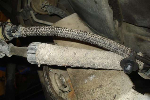I don't know how many gas tanks I've dropped, probably about 20. The absolute best I did was on the most recent one, from Oklahoma and it took 2-3 hours. Those who claim to do it in half an hour, no way. It takes nearly that long to siphon the gas out. Dropping the gas tank is about equivalent to dropping the transmission. Its not "highly skilled" per se, as its just bolts, but everything is at an awkward angle. Its always something with a gas tank. Either the straps don't quite fit, those captured nut (u-nuts) break, and don't even get me started on those stupid quick connect fittings.
As I stated, with an explorer, there is a great alternative. Under the drivers side rear seat is the perfect spot for an access panel. Its quite easy to cut, and not nearly as dangerous as you would think. Plus once its there, changing a fuel pump can be done in 15 minutes. Once you are done you can either put back the piece you cut with tabs, or cut a slightly larger cover and screw it down. then its covered by carpet, and hidden nicely under the passenger seat.
Also, for future reference, on all vehicles, 30k miles is a good number to change fuel filters. I'm sure you could push it to 50k. The last one I changed was on a 2000 explorer that had been on there for 80k, and started to miss on cold mornings. I did all the usual maintenance and found the fuel filter to be nearly impossible to blow through.











